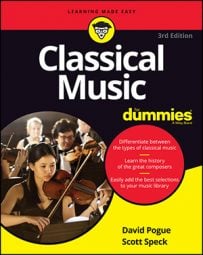When musicians play any old music, in fact, all they have to go on is the composer’s notation. The written notes consist almost exclusively of exact subdivisions of a beat, such as eighth notes — or of exact multiples of a beat, such as whole notes. But in theory, a note can last any length of time.
There was no way in Beethoven’s time to write a note that lasted about two-sevenths of a beat. What would Beethoven have done if he wanted such a note? He could only write an approximation.
The fact is that any written musical notation can only scratch the surface of the composer’s intentions. The duration of a written note may be ever so slightly longer or shorter than the composer was actually feeling.
The composer’s specified tempo (speed) might sound good only in rooms with certain acoustics. Even the addition of dynamics — markings to play loudly or softly, or to grow or diminish in volume — only give the vaguest idea of what the composer wanted.
The earliest composers wrote nothing but the notes themselves — no indication of duration, speed, rhythm, or volume. A Gregorian chant from the Middle Ages looks like an unending sequence of pitches on a musical staff, a bunch of black dots going up and down. How should that be performed?Because chants were sung in a monastery, most people think they should be performed slowly, reverently, without any particular rhythm, and with a gentle ebb and flow of volume — much as you might modulate your voice in a simple prayer. But who’s to say? Maybe they were meant to be screeched and wailed, at the top of your lungs, like a Van Halen guitar solo. No one will ever know.
In the Baroque era, when composers such as Johann Sebastian Bach notated the speed of the music at all, their markings were rudimentary: allegro (cheerful) or adagio (at ease), for example. But how fast is “cheerful,” and how slow is “at ease”? Furthermore, Baroque dynamic markings usually consisted of piano (softly) and forte (strongly) — and nothing in between.
To this day, musicians have no idea whether most Baroque composers ever wanted to hear a gradual crescendo (growing) or diminuendo (diminishing) in volume. As a result, sometimes Baroque music is performed with ever-changing dynamics, and sometimes it isn’t.
Composers in the Classical era added more dynamic markings, and Ludwig van Beethoven was one of the first to use the metronome to specify a certain number of beats per minute. But even then, the dynamic and tempo notations remained inexact.
A crescendo performed by a group of 24 musicians sounds very different from a crescendo made by a big orchestra of 100. And a superfast metronome marking might work comfortably for a small group of consummate virtuosos in a small room with clear acoustics — yet it might sound ridiculously frantic in the hands of a big group of amateurs in a boomy cathedral.
Some composers, especially in the Romantic era and beyond, have tried to overcome this lack of precision by adding extra words. For example, rather than just writing crescendo (growing), a composer might write molto crescendo (growing a lot), or even moltissimo crescendo (growing a heck of a lot). But even then — how much is a lot?
The composer Gustav Mahler, himself a great conductor and interpreter of other people’s works, went to extremes to be understood. He was known to write such things as “from here until the end, make a gradual yet constant increase in volume.” But how gradual is gradual? How loud is the music to begin with? And how loud should it be at the end? Even today, there is no foolproof way to communicate musical intentions in notated form.
The fact is that all written music needs to be interpreted. And that’s where the fun begins. No matter how meticulously the composer has tried to capture his or her ideas on paper, it takes a person (or a group) with imagination and interesting musical ideas to attempt to embody what the composer intended. Music is nothing without living, breathing musicians to bring it to life. Thank goodness for that!

